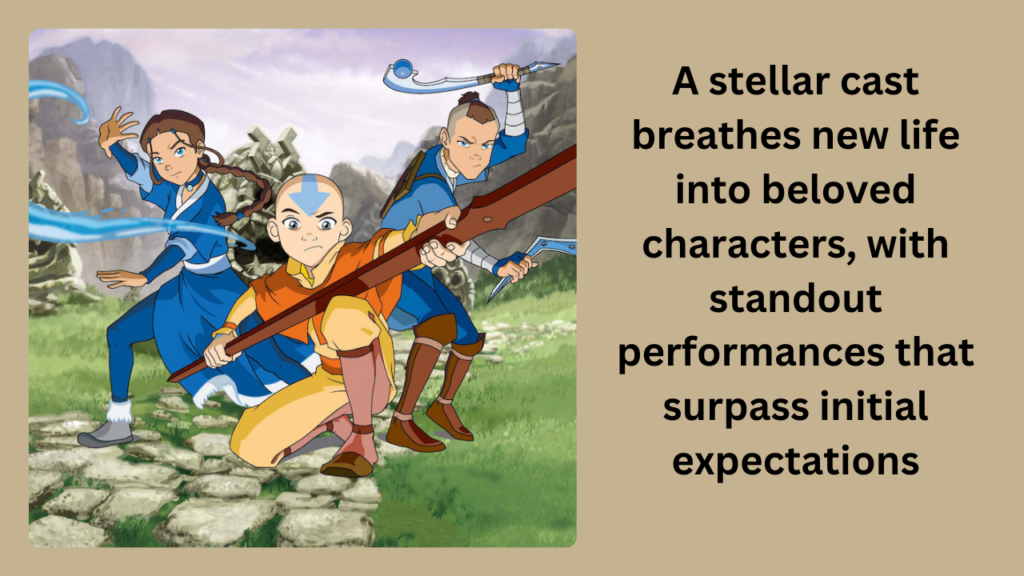The 2005 television series “Avatar: The Last Airbender” was a vast and all-encompassing journey. It woven a tapestry of rich international themes, nuanced allusions to regional and Asian cultures, colorful characters, and action-packed, animated drama. Millions of people watched the series, which received positive reviews and critical accolades. It presented a universe that required no outside confirmation because it was so full, rich, and deep in its own histories, myths, and tales.
Challenges of Success: “The Last Airbender”
Although as we all know, plans don’t always come to pass. The well-known live-action movie “The Last Airbender” endured harsh criticism in 2010 from righteous admirers. Despite having ties to the first series, “Avatar: The Legend of Korra,” the follow-up was not as successful in several areas. The most recent big-budget project from Netflix, “Avatar: The Last Airbender,” followed this trend and shown how difficult it can be to recreate the charm of a well-loved original.
A World of Nations: The Setting of “Avatar: The Last Airbender”

Netflix’s “Avatar: The Last Airbender” follows the events of the first series in a hypothetical Eastern world divided into four nations: the Air Nomads, the Water Tribe, the Earth Kingdom, and the Fire Nation. Every country in this world has a small number of “Benders” who are experts in their particular aspects. Avatar Aang, the master of all four elements, disappears in the middle of a century-long conflict that the Fire Nation has won and represents the only chance for peace. Katara and Sokka, siblings from the Water Tribe, set out on a mission to finish Aang’s training and protect the world from the Fire Nation after learning about Aang, a 12-year-old Air Nomad, who is the last surviving Avatar.
Diverse Storylines and World-building: The Essence of “Avatar”
“Avatar” aims to compress many narratives that were dispersed among several episodes in the original series into a succinct eight-episode tale. It makes use of a variety of economic structures that combine narratives and linkages across disparate, historically established locales—for example, in times of peace. Because of the creators Bryan Konietzko and Michael Dante DiMartino, each subplot, even when changed or rearranged, stays true to the original series, if not exactly in detail. There are many references to both the East and the West in the show. One such instance is the confrontation with the “Kyoshi Warriors” in episode 11 of the series, which alluded to the frightening animals Team Avatar would fight in the NukTuk version.
Casting Choices and Performances
The live-action deal is mostly influenced by the cast of Netflix’s adaption. The portrayal of the Fire Nation is especially noteworthy; Dallas Liu’s interpretation of the mysterious Fire Prince Zuko adds nuance by capturing the rage and vulnerability that precisely balance his persona. Zuko’s troubled and scarred sister Azula is portrayed by Elizabeth Yu as a more complex character than her cartoon counterpart. Daniel Dae Kim’s portrayal of the missing Fire Lord Ozai gives the character a suitable sense of gravity. As a supporting antagonist, Ken Leung’s meek, self-serving Fire Nation Commander Zhao frequently steals the show.
Regarding Soka’s casting, it is exquisite. Ian Ousley does a fantastic job of capturing Soka’s speech tempo, facial emotions, and even the comedic timing of his animated counterpart. But the strength of Team Avatar’s casting doesn’t carry over to the rest of it. While Gordon Cormier’s portrayal of Aang attempts a natural vibe, it frequently comes across as strained, striving to give the character the power his role deserves. Kiawentiio’s Katara feels overly emotional but underdeveloped.
Humor Lost in Translation: The Challenge of Adaptation

The amount of vibrant humor that has been lost in translation is arguably the biggest problem with this version. Reliable humor tools from all-time favorite animated children’s shows, including visual gags, punchlines, looping sound effects, and jungle influences, were included into the 2005 “Avatar” series. Not only can the most recent “Avatar” not adhere to the same brand as the first, but it also can’t foresee how its brand-new comedy vocabulary will translate to a live-action setting. With its eerie, unnatural CGI backgrounds and visual effects, art also falls short of expectations. The show is often extremely basic due to the heavy use of slow-motion images and the insertion of transparent rapid cutaways.
Conclusion: A Reflection of Recent Live-action Animation Adaptations
In the end, “Avatar: The Last Airbender” devolves similarly to the most recent live-action animated Netflix adaptations. At its finest, the show is hardly more than a sentimental reminder that a far superior version of “Avatar” already exists. It has already once again rescued the world.




